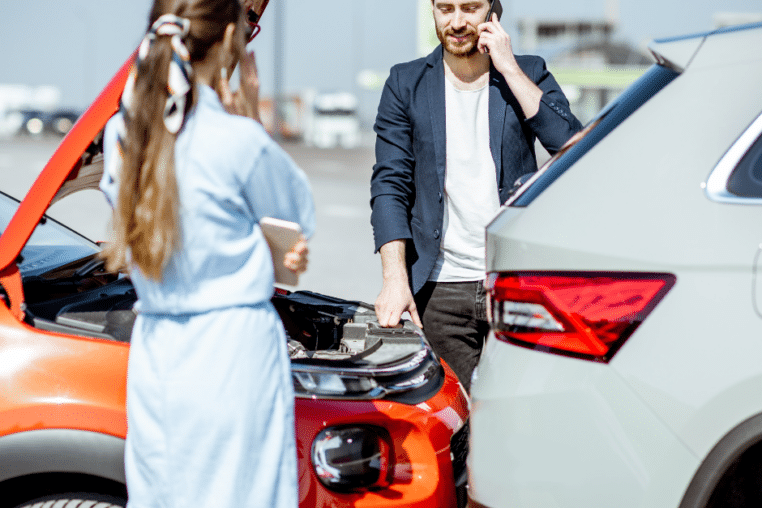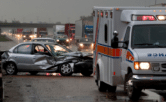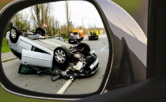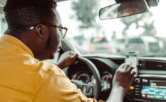
How to Determine Fault in a Las Vegas Car Accident
In the aftermath of a car accident, it is important to determine who was at fault for the crash. Nevada follows an at-fault system, meaning the driver responsible for the accident is liable for covering the other party’s expenses. If you plan to file a personal injury lawsuit after a Las Vegas car accident, you and your lawyer will need to prove that the other driver was at least partially at fault.
Understanding how fault is determined can help you protect your rights after an accident. Insurance companies and opposing lawyers may attempt to shift blame for the accident in an attempt to reduce your potential compensation or deny your claim altogether.
At the Cottle Firm, our dedicated Las Vegas car accident lawyers help our clients fight for the compensation they deserve after car accidents caused by negligence. If you were injured by a negligent driver, we are prepared to investigate your case and gather evidence to establish fault. Give us a call today at 702-722-6111 to learn more about your legal rights in a free consultation.
Nevada’s Fault Laws
In Nevada, the driver responsible for causing the crash is also responsible for covering damages. In no-fault states, each driver files a claim with their own insurance. However, Nevada is an at-fault state, which means injured parties are allowed to seek compensation from the at-fault driver’s insurance provider or file a personal injury claim, if necessary.
Nevada also follows a modified comparative negligence rule (NRS 41.141). Under this system, a driver may recover damages even if they are considered partially at fault, as long as their fault does not exceed 50%. Any settlement or court judgment awarded is reduced by this percentage of fault.
For example, if a driver is found 20% at fault, their settlement will be reduced by 20%. If they are 51% or more at fault, they cannot recover any damages.
Factors in Determining Fault
To determine fault for a car accident in Las Vegas, numerous factors must be considered. Insurance companies, law enforcement, and legal teams all conduct investigations to determine fault. Each piece of evidence helps establish liability.
Traffic Laws and Violations
If the accident occurred due to one driver violating a traffic law, this violation will be a key factor in establishing fault. Running a red light, speeding, reckless driving, DUI, failing to yield, and other violations can establish clear liability. If a driver receives a traffic citation related to the accident, it often serves as strong evidence of fault. However, violations alone do not always determine full liability, as comparative negligence may still apply.
Police Reports
Law enforcement officers who respond to the scene create an official accident report, which includes their observations, statements from involved parties, and any citations issued. While a police report is not the final word on fault, insurance companies and courts consider an officer’s assessment when evaluating claims.
Eyewitness Testimony
Eyewitnesses can provide a third-party perspective to help clarify what happened. Unlike the drivers involved, witnesses typically have no personal stake in the outcome of the case, which can make their statements more objective. Witness testimony can support or contradict the accounts given by the drivers and may influence how fault is assigned.
Surveillance and Dashcam Footage
Video footage from traffic cameras, nearby businesses, or dashcams can provide clear evidence of how an accident occurred. This type of evidence is often difficult to dispute, as it captures the events in real time. Video evidence should be sought quickly after an accident, as some surveillance systems overwrite footage after a short period.
Vehicle Damage Analysis
The location and extent of damage on the vehicles involved can help accident investigators determine how the crash happened. For example, rear-end collisions typically indicate that the rear driver was at fault, while damage to the side of a car at an intersection may suggest a failure to yield. Accident reconstruction experts may also analyze skid marks, debris patterns, and vehicle positioning to provide a more detailed assessment of fault.
Common Car Accidents and Who Is at Fault
In some car accidents, determining fault may be more clear-cut, while others require a more in-depth investigation. Below are some of the most common accident scenarios and how fault may be determined.
Rear-End Collisions
In most rear-end collisions, the driver in the back is considered at fault. Nevada law (NRS 484B.127) requires drivers to maintain a safe following distance so that they can stop in time to avoid hitting the vehicle in front of them.
If a driver is tailgating or distracted and rear-ends another car, they are usually considered at fault. Even if the front driver suddenly brakes, the rear driver is generally expected to have been following at a large enough distance to stop in time.
However, there are exceptions where the front driver may share or bear full responsibility. If a driver reverses unexpectedly, has non-functioning brake lights, or cuts off another vehicle without warning, they may be at fault or at least partially liable.
Left-Turn Accidents
Left-turn accidents are common at intersections and often result in serious injuries. In most cases, the driver making the left turn is at fault because they must yield to oncoming traffic. Nevada law states that a left-turning driver can only proceed when it is safe to do so. Drivers who fail to follow this law may be deemed negligent if a crash occurs.
However, the oncoming driver may be partially or fully at fault under certain conditions. If the driver going straight was speeding, ran a red light, or was driving recklessly, they may be liable for the accident.
T-Bone (Intersection) Accidents
Also known as side-impact collisions, T-bone accidents often occur when one driver fails to yield the right of way at an intersection. These crashes usually happen when a driver runs a red light or stop sign, or fails to obey other traffic signals, and collides with another vehicle crossing the intersection. The driver who violated the traffic rule is typically at fault.
However, fault can be more complicated in certain situations. For instance, if one driver made an illegal turn and T-boned another driver who was speeding or intoxicated, both drivers could bear a portion of the responsibility for the crash.
Multi-Car Pile Ups
Accidents involving three or more vehicles are among the most complex cases because multiple drivers may have contributed to the crash. Pileups often start with an initial collision, such as a rear-end crash, which then sets off a chain reaction involving other vehicles. The driver who caused the first impact is usually considered primarily at fault, but other drivers may share responsibility if they were following too closely or not paying attention.
Investigating a multi-car pileup requires a detailed review of the accident scene, including vehicle damage, skid marks, and any available video footage. Insurance companies and law enforcement will analyze whether secondary crashes were unavoidable or if other drivers could have taken actions to prevent their involvement. Each driver’s level of fault is assessed individually, and those less than 51% at fault may seek compensation.
Hit-and-Run Accidents
Leaving the scene of an accident is illegal in Nevada. In a hit-and-run accident, fault generally lies with the driver who fled the scene. However, proving fault can be challenging if the at-fault driver is never identified. In such cases, victims may need to rely on uninsured motorist coverage (UM) to cover their damages. If law enforcement can track down the hit-and-run driver, they can be held fully liable for the accident.
If the fleeing driver is later found, evidence like traffic camera footage, witness statements, and vehicle debris can help confirm their liability. In rare cases, the hit-and-run driver may not be entirely at fault. For example, if another motorist caused the accident and the fleeing driver panicked and fled, the motorist who caused the crash would at least share liability.
The Role of Insurance Companies in Determining Fault
When a car accident claim is filed, each driver’s insurer conducts its own investigation to assess liability. This process involves reviewing police reports, witness statements, photos, video footage, and any other available evidence to determine who was responsible for the crash. Insurers also consider Nevada’s comparative negligence laws and may assign a portion of responsibility to both drivers.
While insurance companies aim to settle claims efficiently, their primary goal is to minimize payouts. Adjusters often look for reasons to shift blame or reduce the amount they must pay to claimants. This is why accident victims must be cautious when speaking with insurance representatives. Any statements made can be used against the claimant to reduce or deny compensation, especially if they admit partial fault or downplay injuries.
In disputed cases, insurance companies may use accident reconstruction specialists or legal teams to determine liability. If the involved insurers disagree on fault, they may need to negotiate, which can delay claim resolution. In some cases, accident victims may need to take legal action to seek fair compensation, especially if the insurer refuses to offer a reasonable settlement based on the available evidence.
How to Prove You Were Not at Fault
It may be challenging to prove you were not at fault for a car accident, especially when the other party disputes liability as well. However, gathering sufficient evidence and carefully documenting the details of the accident can help you prove that you were not responsible.
Gather Evidence from the Scene
Car accident injury claims hinge on evidence. Take photos of vehicle damage, road conditions, and any skid marks or debris that may provide insight into the events leading to the crash. If possible, take pictures of the other driver’s vehicle and license plate, as well as any traffic signals or signs that may have been relevant. Additionally, be sure to get contact information from witnesses who saw the accident.
Obtain a Police Report
A police report is a key piece of evidence for determining fault. Request a copy of the police report as soon as possible, as it can help prove your version of events and support your claim.
Consult with an Attorney
Proving a lack of fault can be difficult on your own. Fortunately, an experienced car accident lawyer can help by investigating your case and searching for evidence that proves that the other driver was negligent and responsible for the accident.
When to Consider Legal Action
In some cases, despite your best efforts to prove fault or negotiate a fair settlement, you may find that legal action is necessary to recover full damages after a car accident. When insurance negotiations break down or fault is heavily disputed, pursuing a lawsuit can help ensure that you receive the compensation you need and deserve.
When Settlement Negotiations Fail
If the insurance companies involved cannot agree on fault or compensation, it may be time to consider filing a personal injury lawsuit. Insurers often make an initial offer that is far below what you deserve, or they may even deny liability altogether. If you are unable to reach a fair settlement through negotiation, filing a lawsuit may be a viable option. Your lawyer will negotiate with insurers again in an attempt to settle, but the case may move to court if an agreement cannot be reached. There, a judge or jury will have the final say on fault and damages.
When Fault is Disputed
If fault for the accident is disputed and there is significant evidence to suggest that you were not responsible, or that the other party was more at fault, a lawsuit might be necessary. Your attorney can work with accident reconstruction experts, gather witness testimony, and present evidence that supports your case. In some cases, filing a lawsuit can result in a more favorable decision than continuing to rely on an insurer’s decision.
Discuss Your Case With Our Las Vegas Car Accident Lawyers
Were you recently injured in a Las Vegas car accident that you believe was caused by another driver? The experienced Las Vegas car accident lawyers of the Cottle Firm are here to help. We will stand by your side through each step of the legal process, from filing a claim to taking the case to court, when necessary. Call the Cottle Firm today at 702-722-6111 to discuss your Las Vegas car accident case in a free consultation.



